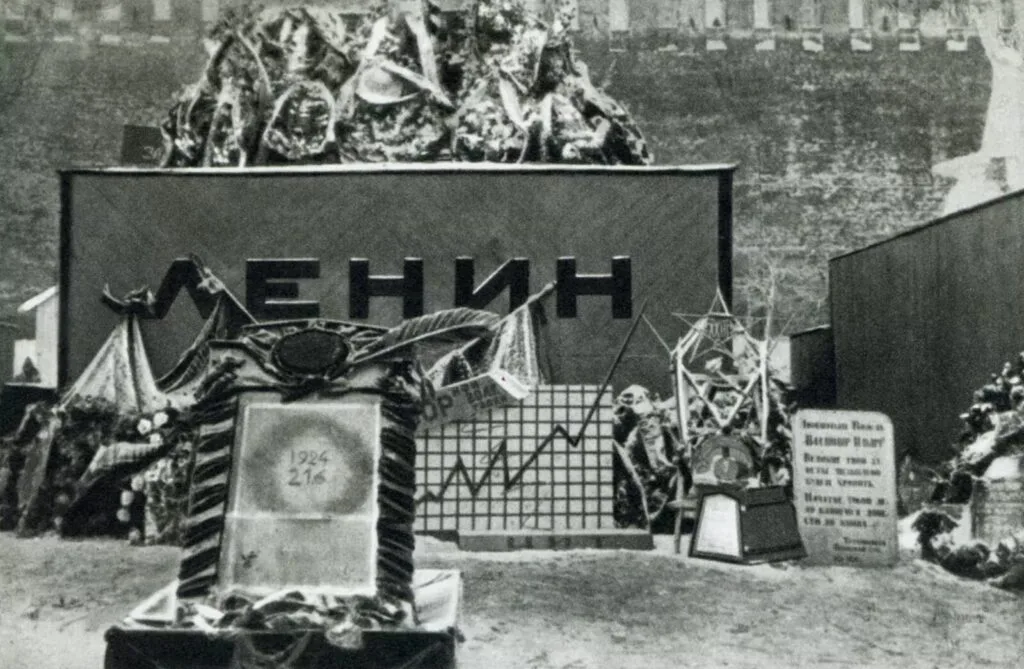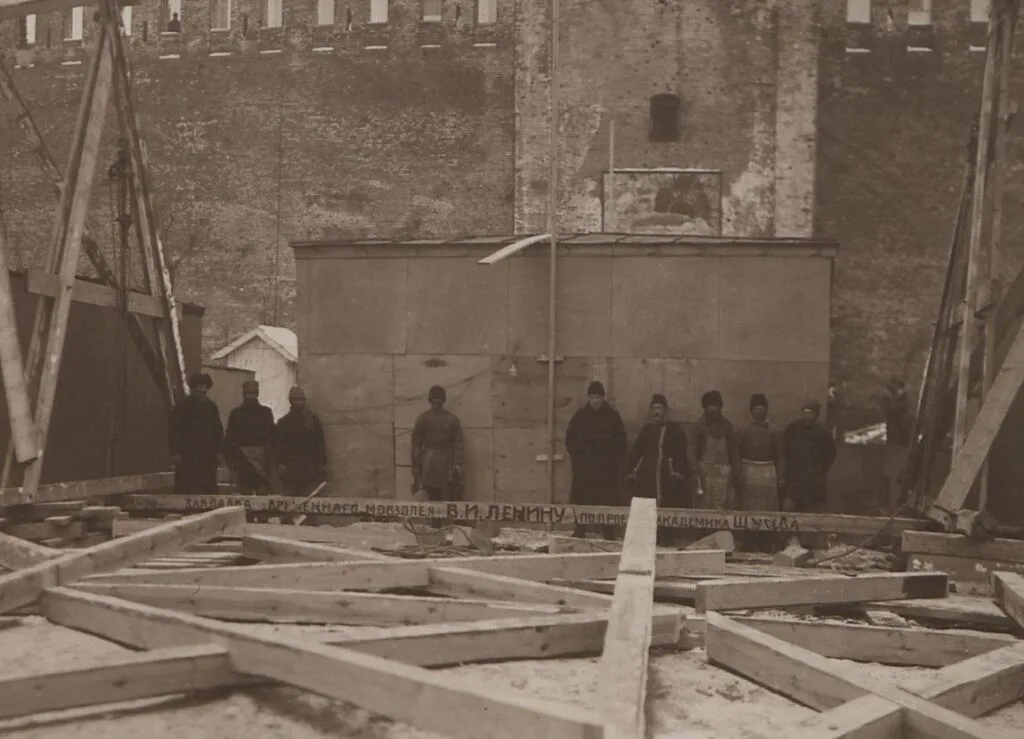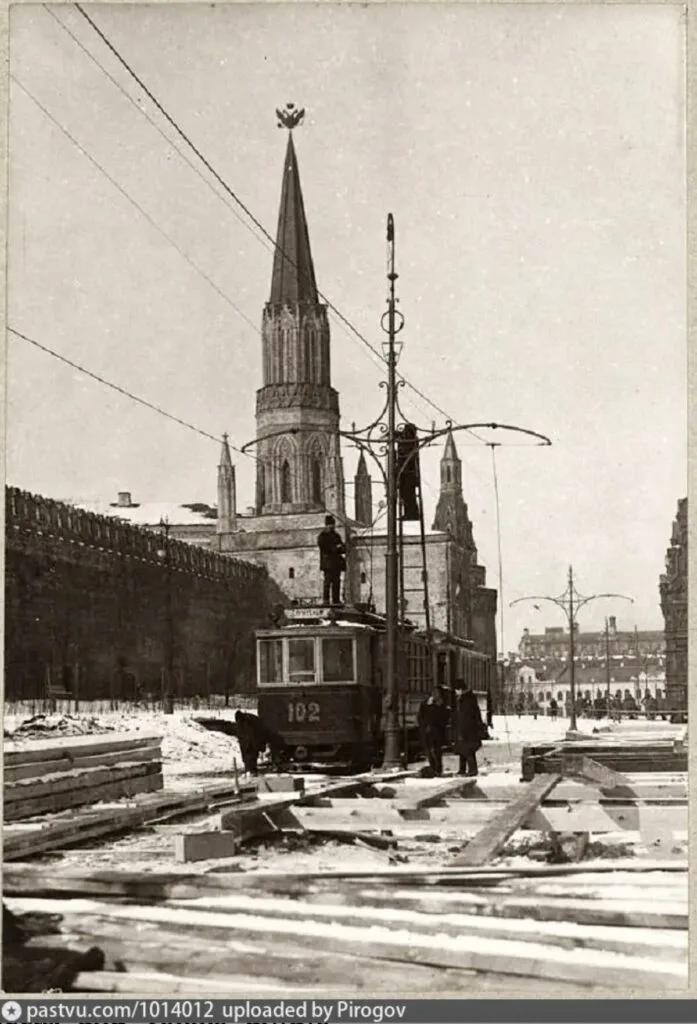There is an opinion in popular science literature and on the Internet that the Patriarch of Moscow and All Rus' reacted to the news of a sewer pipe break in the Lenin Mausoleum with an extremely hostile statement towards the leader. We checked whether such publications are justified.
In different sources, the versions of the appearance of this phrase vary slightly, but the essence remains the same: supposedly during the construction of the first wooden Lenin Mausoleum, a sewer pipe was damaged, which is why the foul-smelling slurry (either immediately or a few weeks later, when the frozen soil thawed) began to flood the leader’s tomb. The story ends the same in all versions: “Having learned about this, Patriarch Tikhon said: “By the relics and the oil.” This story can be meet V social networks, publications Media, on entertaining And local history sites, in collections of quotes, as well as in popular science books. The story even ended up in the biography of the mausoleum architect Alexei Shchusev, published in 2023 in the series “Life of Remarkable People”.
Vladimir Lenin passed away January 21, 1924. The decision that the chief's body should be preserved and subsequently made available to the public was made shortly after his death. Already on the night of January 24, Shchusev received the task as soon as possible (the funeral was scheduled for January 27) to develop a project for a public crypt (temporary for now) for Lenin. The public learned about this decision on January 25, when the Presidium of the Central Executive Committee of the USSR adopted resolution:
“To meet the wishes expressed by numerous delegations and appeals to the Central Executive Committee of the USSR and in order to provide everyone who does not have time to arrive in Moscow on the day of the funeral with the opportunity to say goodbye to their beloved leader, the Presidium of the Central Committee of the USSR decides:
1. Keep the coffin with the body of Vladimir Ilyich in the crypt, making the latter accessible to visitors;
2. Build a crypt near the Kremlin wall, on Red Square, among the mass graves of the fighters of the October Revolution.”
On the same day Shchusev told about his project on the pages of the newspaper “Evening Moscow”: “The basis for the mausoleum being built is a cube - a symbol of eternity. The mausoleum is a crypt intended for wide communication with the masses of the people. The design of the mausoleum crypt provides a number of amenities for the entry and exit of a large number of people. On top, the inside will be mirrored with two ventilation gaps and special lighting at night. The color of the mausoleum inside is red and black. According to the instructions of the doctors, for better preservation of the body, the temperature inside the crypt will be maintained at zero degrees, which will be achieved by a special sawdust coating in the lower part of the crypt. The mausoleum will be the first in the world by its type.”

There was little time for construction - all the work needed finish by 18:00 January 26. It turned out that due to the frosts that winter, the soil froze to a depth of 2.5 arshins (about 178 cm). The task was also complicated by the discovered remains of the stone wall of the Alevizov moat, which surrounded the Kremlin in the 14th–17th centuries. It was decided to call sappers to help the diggers. They were led by military engineer I.E. Korostashevsky, who was then in charge of all demolition work in Moscow. Vladimir Bonch-Bruevich, a member of the commission for organizing Lenin’s funeral, wrote in memoirs: “This specialist had difficulty agreeing to take on this risky and responsible work: he was frightened by the proximity of the Kremlin wall, on which in this very place there was an allegorical image of Freedom. Right there, very close, stood the figure of a worker, and behind him, between the supposed mausoleum and the wall, was the grave of [the Chairman of the All-Russian Central Executive Committee of the RSFSR] Y. M. Sverdlova. Thus, demolition work had to be carried out in the surroundings and in the vicinity of such monuments and places that in no case should have been damaged.” January 25 “Evening Moscow” reported: “Before one o’clock in the afternoon, about 40 explosions were carried out. There are at least 25 more explosions to come. The strength of the latter is so significant that the bricks, flying into the air, fall near the GUM building [on the opposite side of Red Square].”

No documentary evidence that blasting work damaged the sewer system could be found in the sources of those years. The press discussed only possible problems related to the spring flood. “The strength of the structure, according to competent persons, is not in danger during the spring warming of the earth. The soil here is completely dry, and the groundwater is much lower than the foundation of the mausoleum,” wrote "Evening Moscow".
Lenin's funeral took place, as planned, on January 27, 1924. At 4 o'clock in the afternoon the coffin with the body contributed to the mausoleum. At the end of January (the exact date has not been preserved), the former director of the First St. Petersburg Cadet Corps Fyodor Grigoriev wrote down diary: “Now they are gossiping that Lenin’s grave is filled with sewage: the grave was built during severe frosts (down to -25 ° C), and therefore the soil had to be blown up, these explosions destroyed the drainage pipes. I think it's gossip." This is the first known mention of rumors of such problems during the construction of the mausoleum.
By the end of February the story had spread so widely that wrote “Evening Moscow”: “In recent days, some people have been spreading rumors around the city about a pipe rupture allegedly occurring under the foundation of the Mausoleum of V.I. Lenin, as a result of which, according to the same rumors, water penetrated into the interior of the mausoleum. Without attaching the slightest significance to these ridiculous rumors, the editors, from an absolutely competent and knowledgeable source, report that the rumors are without any basis and are completely untrue.” On March 6, engineer A. A. Izmailovsky, who worked on the construction of the mausoleum stated: “The sewer pipes are laid to the side of the crypt at a depth of seven fathoms (almost 15 m - editor’s note), while the foundation of the crypt is laid at a depth of only one fathom. In sewer pipes that go down to the Moscow River, liquid flows by gravity, without any pressure. Consequently, no rise in its contents can occur. It would be a different matter if it were a water pipe, where water flows under high pressure. But there are absolutely no such pipes near the mausoleum.”
Izmailovsky’s words are indirectly confirmed by the fact that immediately in front of the mausoleum building at that time functioned tram line - if there were sewer pipes here, problems with them would have arisen even during its installation. Most likely, the sewerage ran closer to the GUM building and in this case it could hardly have threatened the mausoleum in any way. In addition, Bonch-Bruevich in 1919 was Chairman of the Special Committee for the Restoration of Water Supply and Sewerage in Moscow, which means he had complete information about the city’s sewer networks and could take this data into account during the construction of the mausoleum.

Nevertheless, rumors continued to spread. On March 3, I wrote a similar story in diary artist Alexander Benois (he, like Grigoriev, lived in Leningrad): “Shchusev was arrested (according to Troinitsky). He was supposedly ordered to carry out work at Lenin’s grave, and he came across a drain pipe, the contents of which flooded the coffin with the deceased. The wits find that Ilyich is swimming in “gold”. In general, there are a lot of evil witticisms and anecdotes in which all kinds of people compensate for their annoyance at the pomp that hides the death of the “leader of the proletariat.” March 18 Muscovite Nikita Okunev wrote: “Due to the proximity of sewer pipes, they hastened to think that this crypt had turned into something obscene for a week, due to a faulty pipe. Indeed, there was no admission there for a whole month, but this was probably explained by the need to make amenities in this dungeon both for preserving the corpse in ostentatious form and for the entry and exit of visitors.”
The temporary closure of the mausoleum to the general public was indeed announced on January 29. At the same time to be specified, that access to Lenin’s grave is still allowed to “out-of-town organizations that were late for his funeral” (which would hardly be possible in the event of a sewerage accident).
February 11 “Evening Moscow” informed readers that the entrance to the mausoleum is still closed to the public: “The work to bring Lenin’s grave with the mausoleum built above it to completion continues and will end no earlier than in two weeks. In the last two days, work has begun to re-cover the entire external structure with cork insulation to protect the internal atmosphere of the crypt from heating up during the warm season. Below the base of the walls, trenches are dug and filled with clay to prevent groundwater from penetrating to the base.”

No information about Shchusev’s arrest during this period was found in the sources available to Verified. It is known that throughout February 1924 the architect continued to work on improving the design of the temporary mausoleum and gave the press comments about this, and February 29 gave a report on the reconstruction of Moscow at a meeting at the Moscow Communal Services.
On March 28, an entry about gossip around the mausoleum appears in diary Vice-President of the All-Ukrainian Academy of Sciences Sergei Efremov:
“Rumors from Moscow claim that a sewer pipe in the Lenin Mausoleum cracked and flooded it. There are poems about this.
First version:
Our Russian Messiah has faded away,
And grateful Russia
To the sound of guns and mortars
I lowered his corpse into the toilet.Second edition:
The unrecognized messiah is buried here,
He wanted to conquer the whole world.
Ungrateful Russia
I made a toilet for him.And finally, one more:
Nikolai has died -
in Bose,
And our Lenin -
in manure."
In other words, already in the first weeks after the construction of the temporary Lenin Mausoleum began on Red Square, rumors about sewage problems that arose during construction spread not only in Moscow, but also beyond its borders. However, the first mention in this regard of Patriarch Tikhon and the biting phrase attributed to him is recorded only a few months later. August 27, 1924 at diary philologist Nikolai Mendelson writes: “An anecdote related to recent conversations (probably nonsense) that the sewer pipes running there burst in Lenin’s crypt. The patriarch allegedly found out about this and, after being silent for a while, said: “By the relics and the oil!”
There is no earlier use of this expression either in the National Corpus of the Russian Language or in other sources. It was most likely actually invented in 1924, but the question of its authorship remains open. The expression does not appear in the two-volume book "Contemporaries about Patriarch Tikhon", where many conversations with the patriarch on various topics are reproduced, nor in the book "Investigative case of Patriarch Tikhon. Collection of documents based on materials from the Central Archive of the FSB of the Russian Federation"(although a harsh statement about the leader could well have become the reason for another denunciation), nor in the work of Protopresbyter Vasily Vinogradov"About some of the most important moments of the last period in the life and work of Patriarch Tikhon (1923–1925)" In some publications approved, that Bonch-Bruevich wrote about the words of the patriarch, but there is no such episode in any of his published books. There is no information in open sources that there is a previously unpublished diary or memoirs of a prominent Bolshevik preserved somewhere in the archives. In the work of political scientists Dora Shturman and Sergei Titkin “The Soviet Union in the mirror of a political joke“This story is recorded in a slightly different form, without mentioning Patriarch Tikhon: “A sewer began to flow under Lenin’s mausoleum. Experts could not find the damage. We decided to ask one omniscient elder what to do. The elder thought and said: “According to the relics and the oil.”
Thus, although this catchphrase actually appeared during the lifetime of Patriarch Tikhon, there is no evidence that the church hierarchy uttered it. Apparently, his contemporaries added his name and supposed statement to a story that appeared shortly after the construction of Lenin's temporary mausoleum began. Although sources from 1924 record rumors of sewerage problems during construction, there is no documentary evidence of this either.
Cover photo: PastVu
Read on topic:
- "BBC Russian Service". 23% Lenin. The mausoleum on Red Square turns 100 years old
- Five quotes attributed to Lenin
- Is it true that Lenin died of syphilis?
If you find a spelling or grammatical error, please let us know by highlighting the error text and clicking Ctrl+Enter.






